Beginner Guide: Sourdough Starter
So you’ve decided to jump into the world of sourdough. Now what? This post will teach you all about sourdough starter and the fermentation cycle. It’s a great place to start if you are just getting started in the wonderful world of sourdough and naturally yeasted breads. If you don’t yet have a sourdough starter, you can make one here, get a dehydrated one from my online class or purchase one.
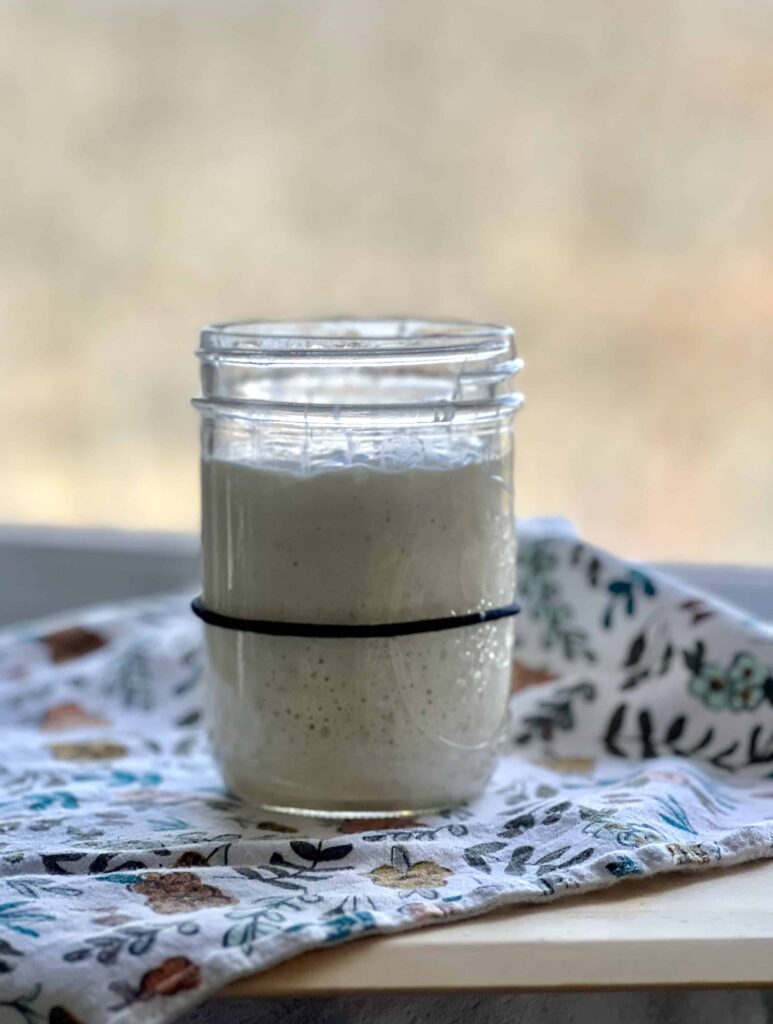
Sourdough Starter
A sourdough starter is used to leaven bread. It is the original way bread was made for thousands of years. Commercial yeast wasn’t introduced until the 1800s (and wasn’t popular until the 1900s). Sourdough was the way bread was made for many years and it has so many health benefits too! Scientifically:
A sourdough starter is a community of bacteria and wild yeast in a symbiotic relationship used to raise dough.
Bacteria acidifies the dough and wild yeasts leaven (or raise) the dough through the production of carbon dioxide. Fresh flour is their food. Wild yeast turns the flour into carbon dioxide gas bubbles and more yeast. Bacteria turns the flour into sugar that the yeast feeds on. It also produces tangy acids and more bacteria. Both the bacteria and wild yeast contribute different flavors to the bread and properties that keep bread fresh longer and are good for the gut.

Fermentation Cycle of a Sourdough Starter
Sourdough grows/is maintained through repeatedly feeding or refreshing a culture of starter with fresh flour and water. Typically you take a small amount of ripe or mildly over-ripe starter and feed it a ratio of fresh flour and water. Mark your jar so you can easily watch the fermentation process. The starter will rise as the yeast increases and fall when the yeast run out of food. Take a small percentage of the ripe/over-ripe starter to feed on the fresh flour and water, and discard the remaining amount of the starter. This starts the fermentation cycle over again. Typically a sourdough starter should be fed a consistent amount of flour and water, on a daily basis, once or even twice a day (or on a weekly basis if it is stored in the refrigerator).
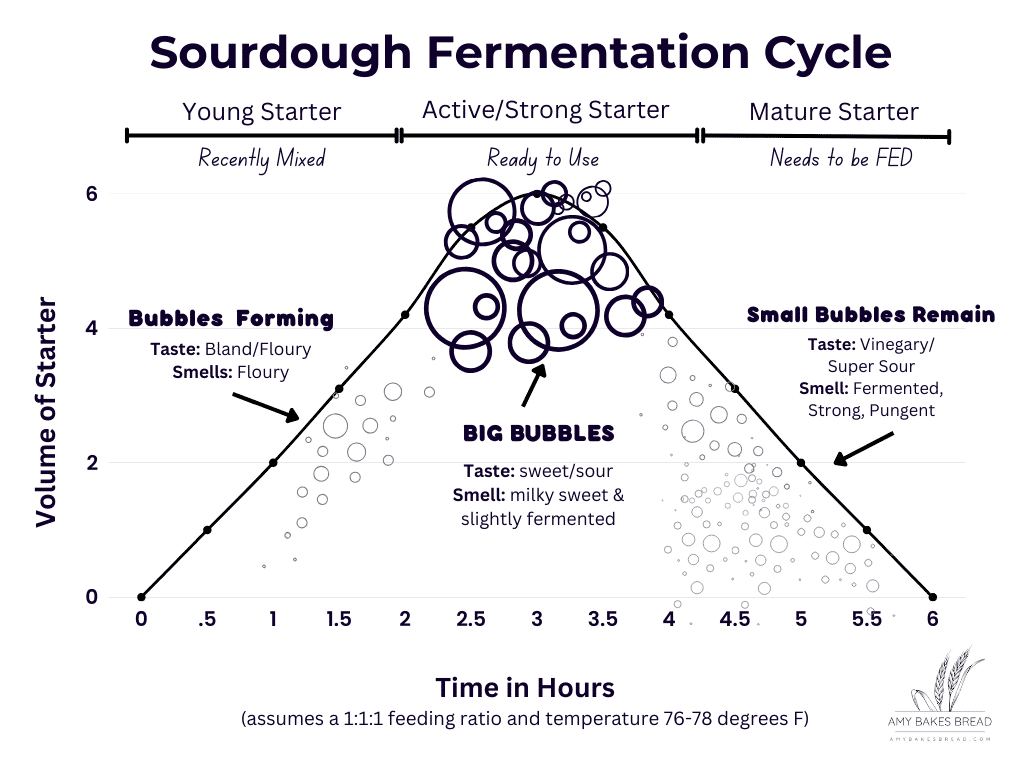
When Is A Sourdough Starter Ready to Use?
Once your starter is rising and falling predictably, you are ready to use it in a recipe or use it to make a levain. A levain is a pre-ferment mixture that is used to make a specific loaf of bread. You can find information on the difference between a sourdough starter and a levain here. In order to maximize the yeast and get the best results possible, it’s important to know the signs for when a sourdough starter is ready to use. The following shows the fermentation cycle a sourdough starter goes through and when it is ready to use.
- Just Mixed Starter– fresh smell, no sourness, little to no rise, no bubbles
- Young Starter–sweet with just a touch of sour notes, beginning to rise, scattered bubbles
- Ripe Starter–sour undertones, doubled in size, many bubbles, just reached its highest point and is starting to go back down USE NOW OR MAKE LEVAIN
- Overripe starter–bubbly/frothy, collapsing in the jar sour smelling/vinegary USE NOW, MAKE LEVAIN NOW OR REFRESH STARTER
- Very overripe starter– layer of “hooch” on top, very liquidy, vinegar/harsh nail-polish type smell–Refresh right away and may need a couple of refreshments to build up all the good bacteria/wild yeast again





How Much Should I Feed a Sourdough Starter?
This is really up to you. The goal is to find a ratio of starter to flour to water that fits in with your life routine and how frequently you want to bake bread. You can control the timing when your sourdough starter is ready to use or needs to be fed/refreshed by increasing or decreasing the amount of sourdough culture you are feeding it with AND increasing and decreasing the temperature. For example:
- If you feed your sourdough starter at a weight ratio of 1:1:1 (1 part ripe sourdough starter, 1 part flour, 1 part water–all equal weights), your sourdough culture will be ready to use in about 3-4 hours if kept at 78 degrees F.
- Example: Take 50 grams of ripe sourdough starter and place in a clean jar. Add 50 grams of flour and 50 grams water to the starter and stir. It will become ripe in about 3-4 hours if kept at 78 degrees F.
- If you feed your sourdough starter at a weight ratio of 1:10:10 (1 part ripe sourdough starter, 10 parts flour, 10 parts water), it will take a lot longer for the yeast to consume the fresh flour. Your sourdough starter will be ready to use in about 12 hours, and it won’t need to be refreshed again until 24 hours later (assuming 78 degrees F).
- Example: Take 5 grams of ripe sourdough starter and add it to a clean jar. Add 50 grams flour and 50 grams water. Stir. It will become ripe in about 12 hours if kept at 78 degrees F.
Sourdough Ratios Explained
The table below shows examples of ratios used to feed a starter. Assuming 76-78ºF temperature, the table shows the time it will take for a starter to reach its peak and then the time it needs to be refreshed. The starter should be refreshed no later than when it’s just fallen back to the level of pre-fermentation stage. If it is allowed to sit beyond that point, the starter will begin to break down and will need extra measures to “rescue” and refresh it. For a healthy and less-sour starter, refresh your starter a little after the peak height, when the starter is just ripe. Read more about ratios here.
| Ratio | Example in Grams | Ripe/Reaches Peak/Ready to Make Levain | Over-ripe/ Needs to be refreshed |
| 1:1:1 | 10 grams ripe starter, 10 grams flour, 10 grams water | 3-4 hours | 7-8 hours |
| 1:2:2 | 10 grams ripe starter, 20 grams flour, 20 grams water | 5 hours | 10 hours |
| 1:5:5 | 10 grams ripe starter, 50 grams flour, 50 grams water | 6-7 hours | 12-14 hours |
| 1:10:10 | 10 grams ripe starter, 100 grams flour, 100 grams water | 10-12 hours | 24 hours |
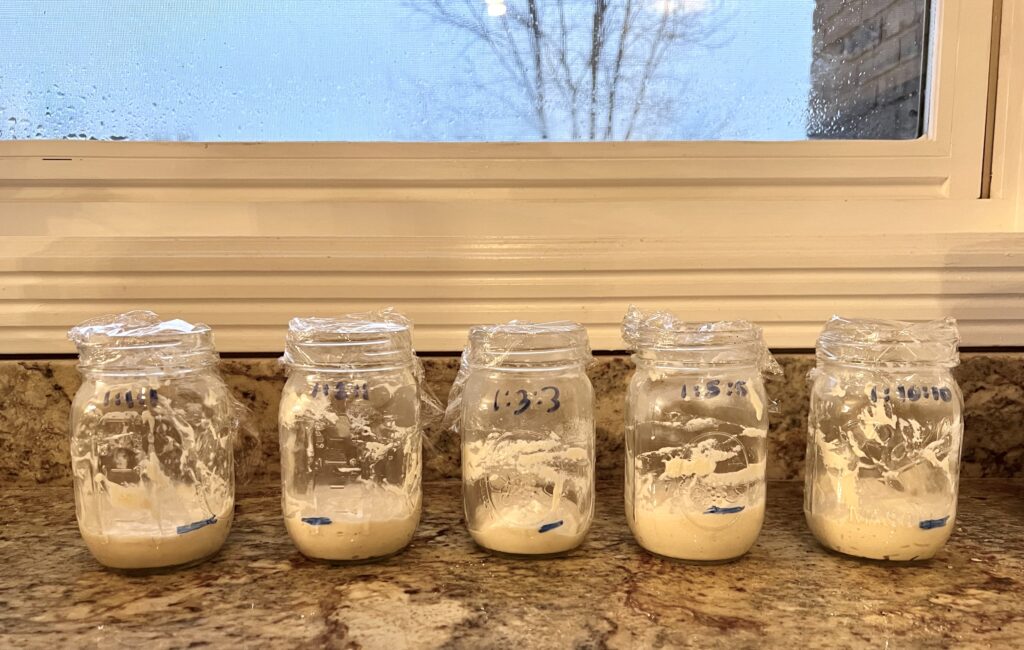
Sample Sourdough Starter Feeding Process
Ingredients Ratio (by weight) – 1:10:10 (1 part starter, 10 parts flour, 10 parts water)
Approximate Frequency: Once per day (Adjust depending on temperature/season)
- Place a jar on the scale. Add 10 grams of ripe sourdough starter to the jar.
- Discard the rest of the ripe sourdough starter (once the starter is mature and ready to start baking with, you can save this discard in the refrigerator to use in “discard” recipes).
- Add 100 grams of flour (80 grams white flour/20 grams whole wheat flour or 100 grams bread flour or 100 grams all purpose flour) to the jar.
- Take the temperature of the flour/starter and add either 100 grams warm or cold water depending on the temperature of the flour/starter.
- Stir with a spatula and mark the jar at the top of the starter.
- Cover lightly and set in a warm place (76-78℉) for about 10-12 hours until peaked and ready to use.
- Use the starter when it’s peaked and just starting to fall for best results. You can also use the starter as it falls.
- You can re-feed the starter any time as it falls back down. At a minimum, once the starter has completed the fermentation cycle, it should be fed again.
*If you’d like to feed twice a day, try a 1:5:5 feeding (20 grams starter, 100 grams flour, 100 grams water). Feeding twice a day will allow you to bake more frequently.
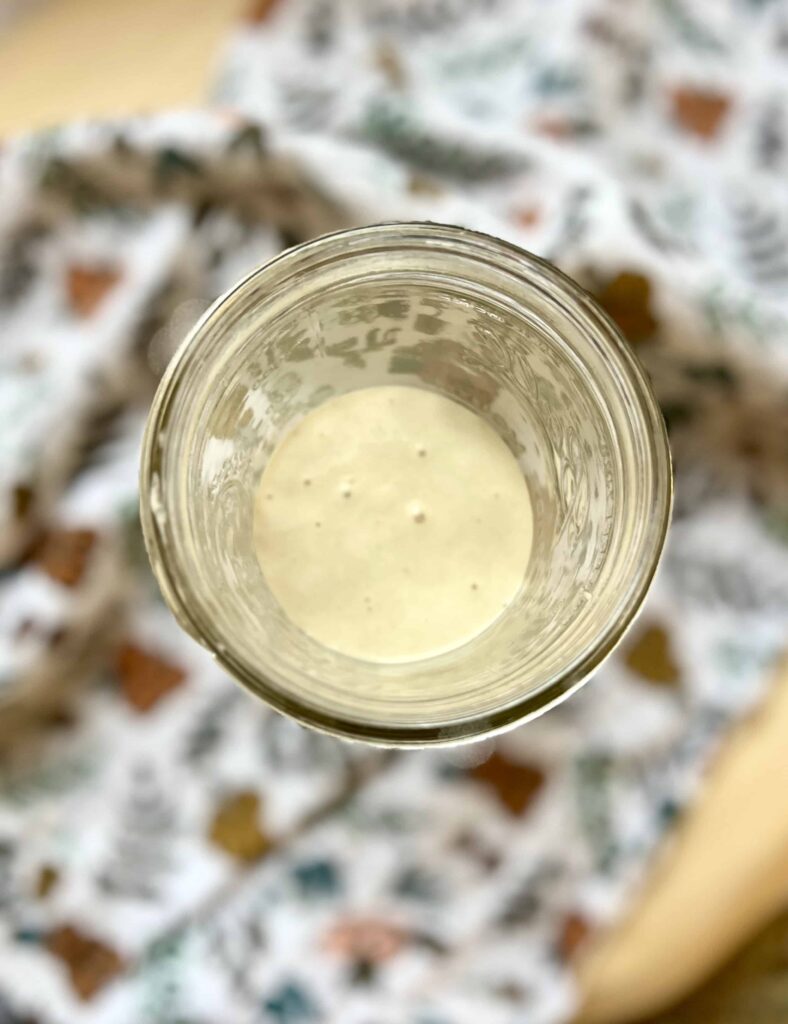

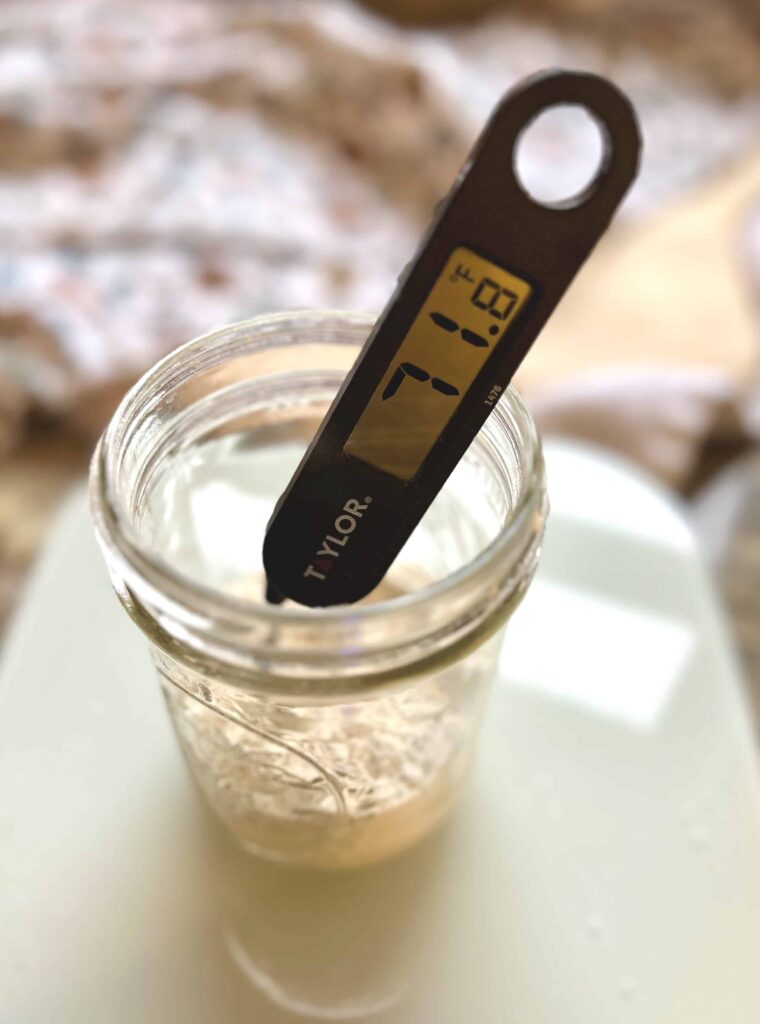
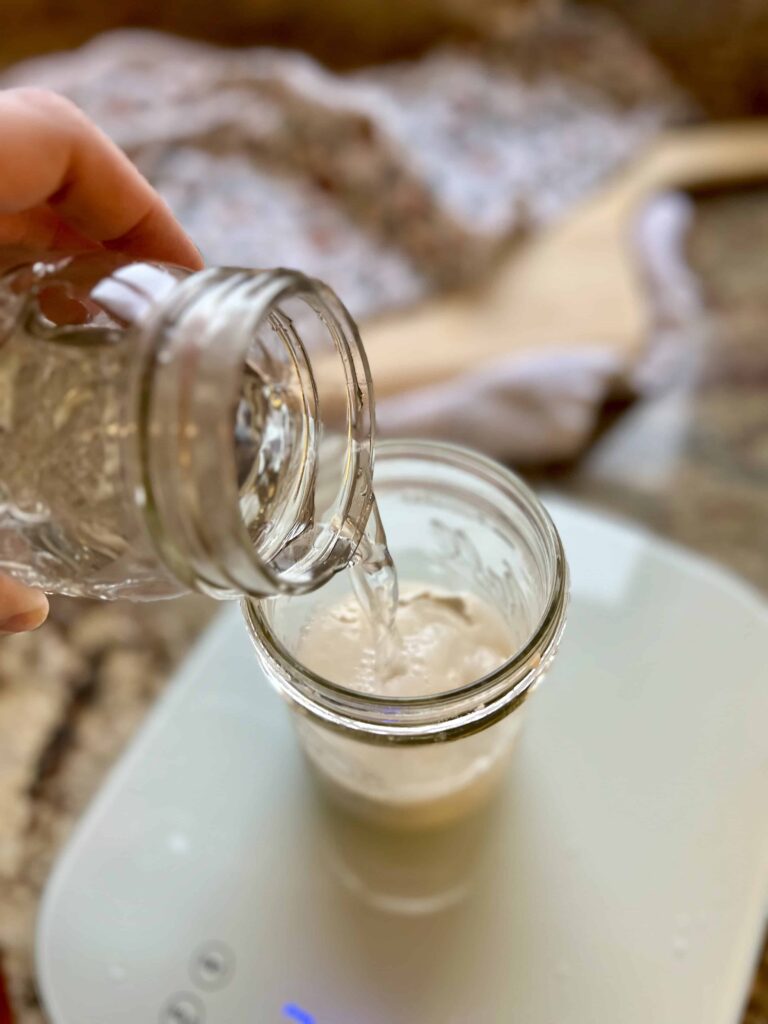

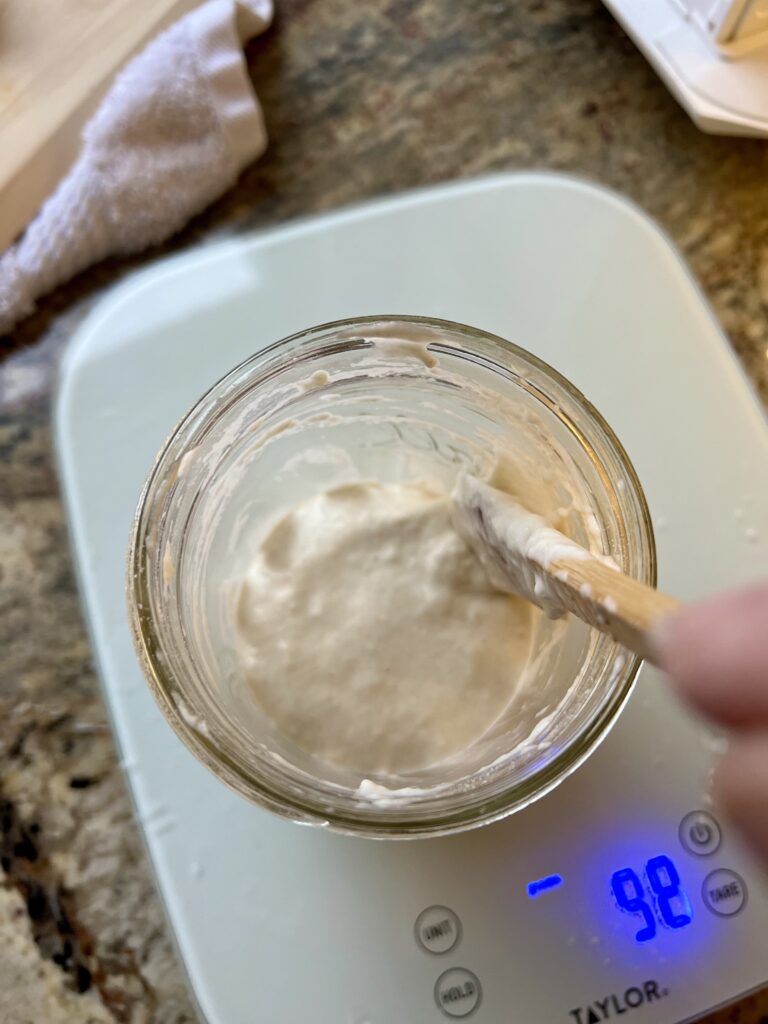
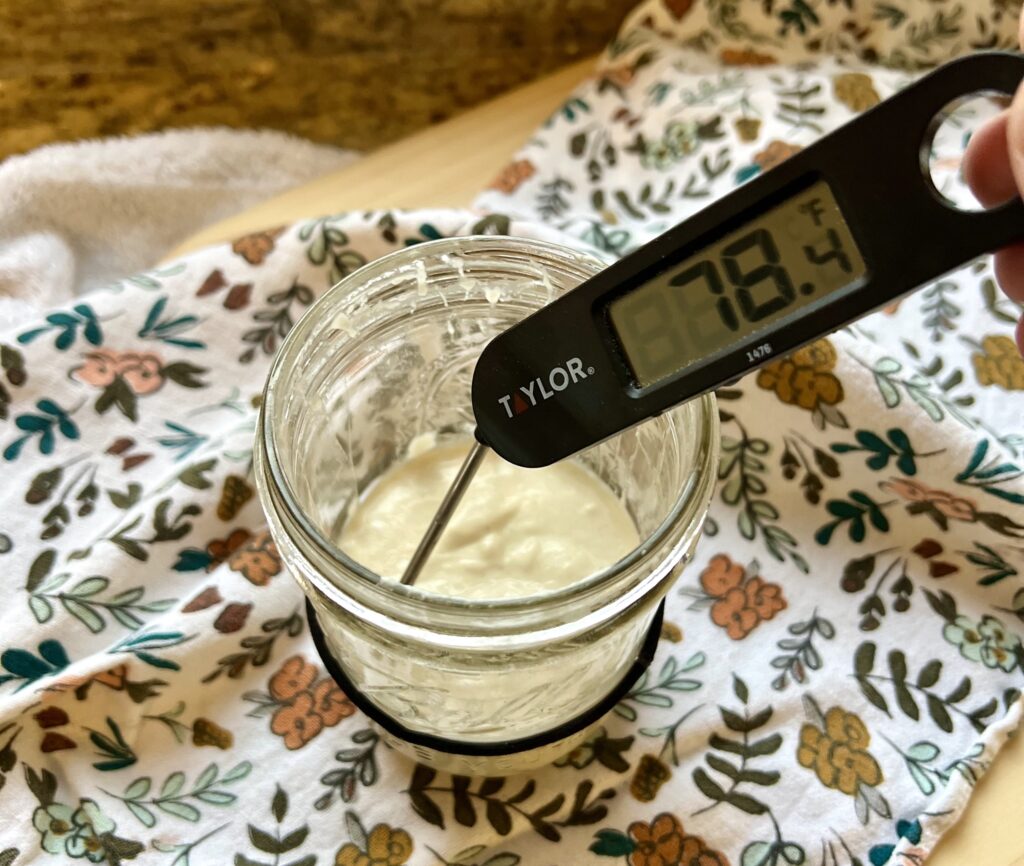
Keeping a Smaller Sourdough Starter
You may decide to keep a small sourdough starter instead of a larger one. The size of the starter doesn’t matter all that much. You can quickly build a levain or make more starter just based on the ratios of starter to flour to water. Choose a small jar. Add 1-2 grams of starter, 20 grams of flour and 20 grams of water. Mix. Continue feeding this smaller starter throughout the week or keep in your refrigerator and feed.
Top Sourdough Starter Tips
- Choose a routine that fits with your life
- Watch for changes in the seasons/temperature (and find ways to compensate)
- Decide how often you want to bake and adjust accordingly
Maintaining Your Sourdough Starter
As a general rule of thumb:
- If you want to make bread every day: feed your starter once a day (or even twice if you want to bake multiple times)
- If you want to make bread once a week or simply maintain the starter for less frequent use: keep your starter in the refrigerator and feed it once a week
- How I use a refrigerated starter: I typically feed my starter a 1:1:1 ratio and let it sit until it’s almost doubled/peaked. Then I’ll stick it in my refrigerator. When I want to bake with it, I’ll take some of that peaked and active sourdough starter from my fridge and use it to make a levain. I take from that jar as long as it is peaked/bubbly and smells milky sweet (not overly acidic) and use it to bake with throughout the week, straight from my fridge, using warm water to make my levain. If you consistently feed your starter, this method works well. If your starter is more sluggish, give it a couple of feeds to strengthen it before using in your dough.
Temperature and Time in Sourdough
Temperature is one of the most important variables in making sourdough bread. It will affect how quickly your starter will rise and fall (or if it will rise and fall at all). Always shoot for 76-80 degrees F for the “room temperature” of your sourdough starter, levain and dough. If your ingredients are cold, add warm water (not going too much above 90 degrees) to help maintain the temperature. Keep in mind that the overall process of preparing and baking with sourdough takes a lot longer than with dough made with commercial yeast (instant/dry active) – as much as two or three times as long. The good news is that a lot of this time is fermentation and rise time, not hands-on time!



Sourdough Beginner Guide
Want more in-depth Sourdough instruction?
Check out my online sourdough classes or take a class in person.

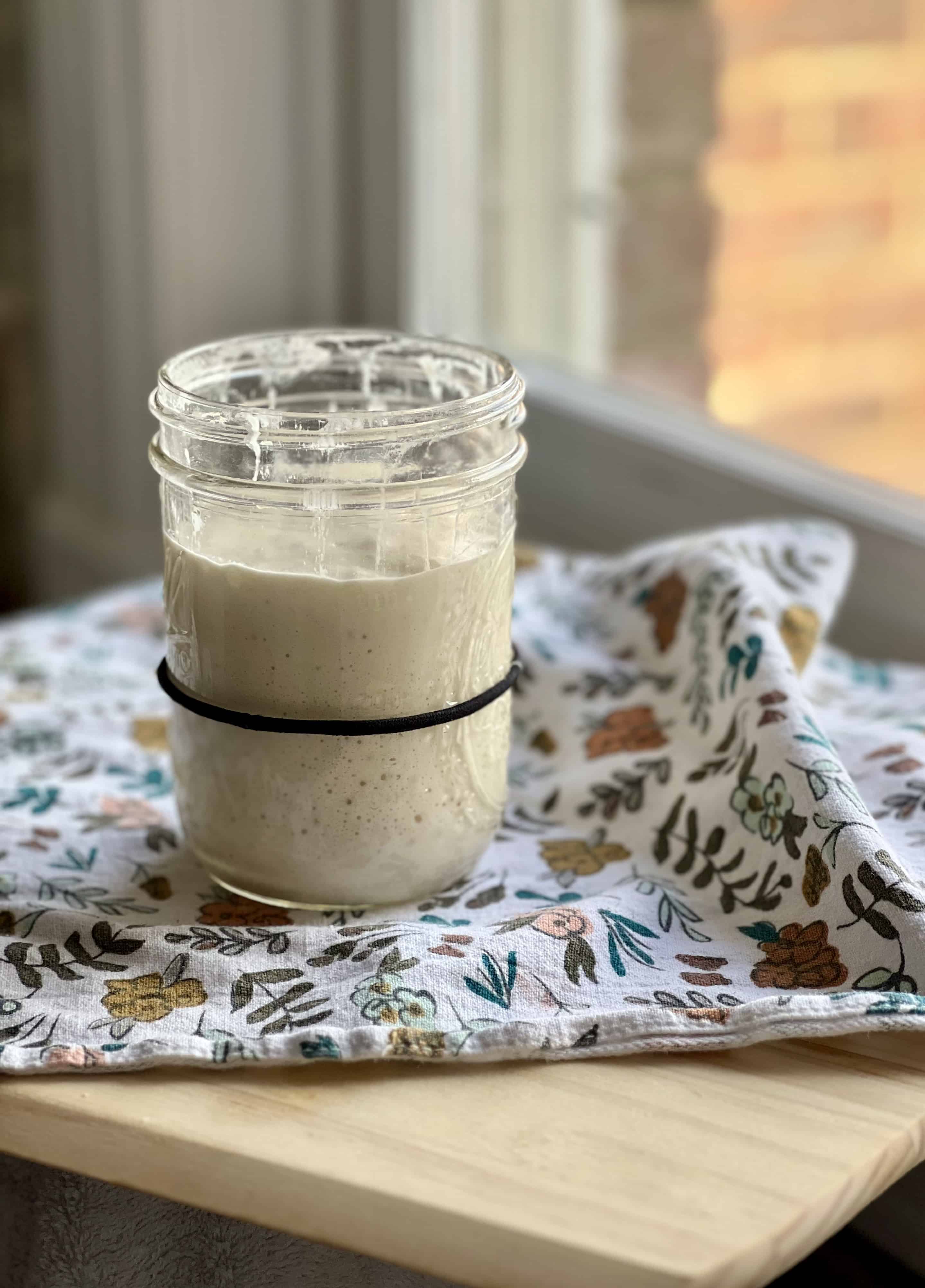
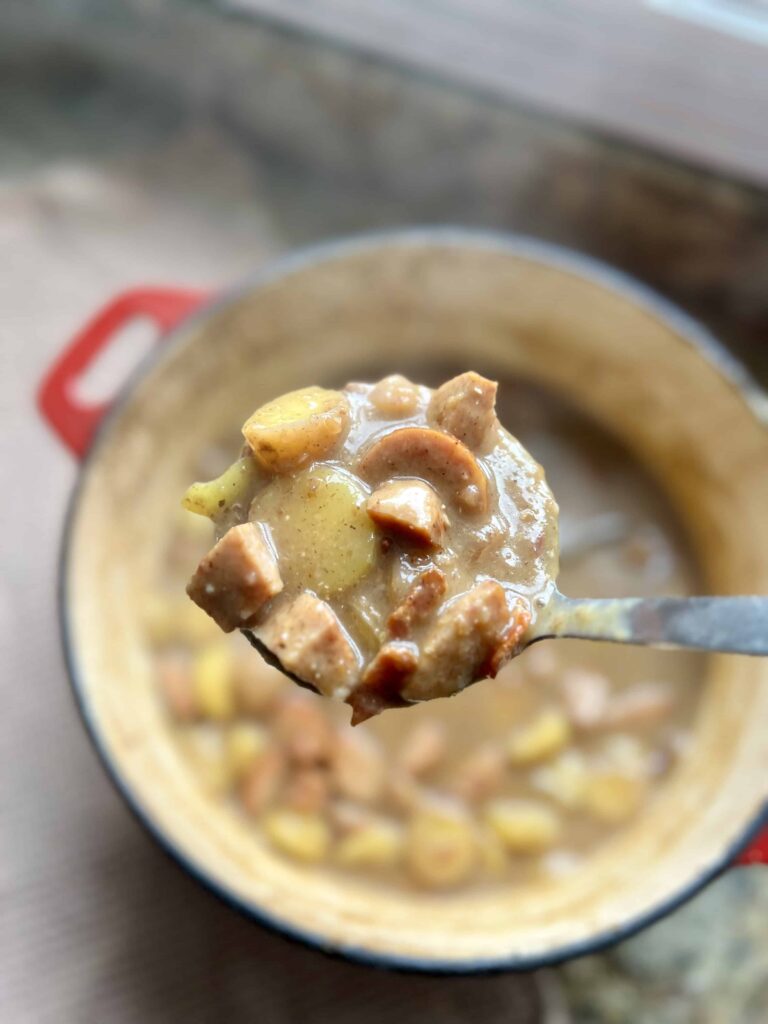
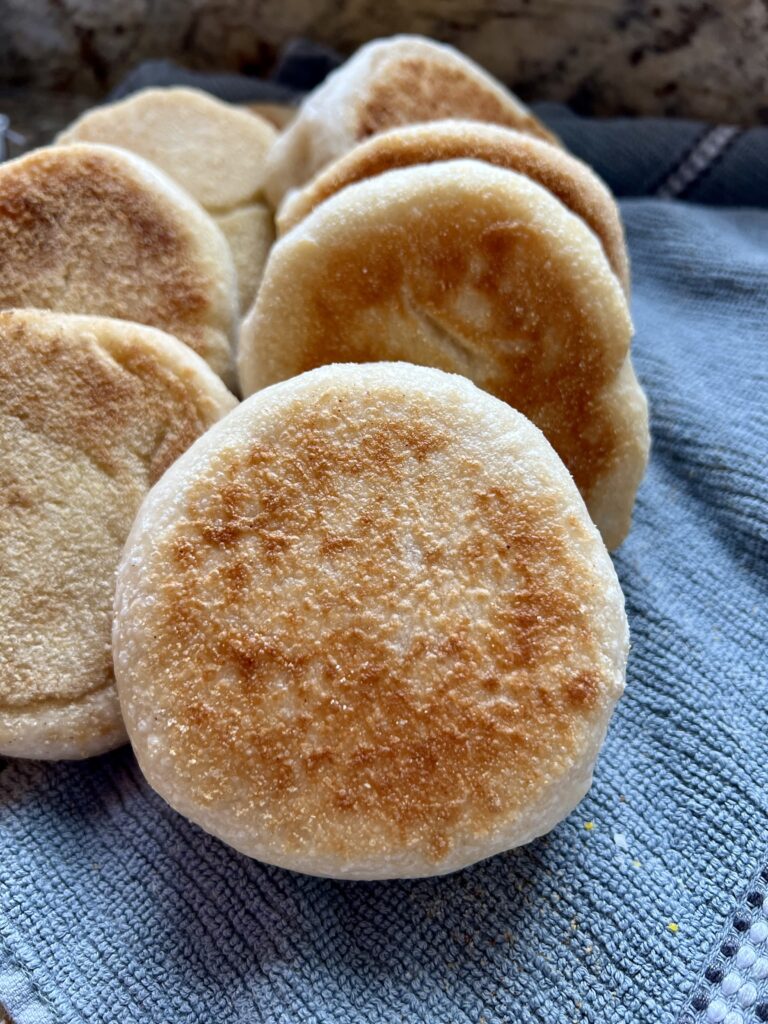
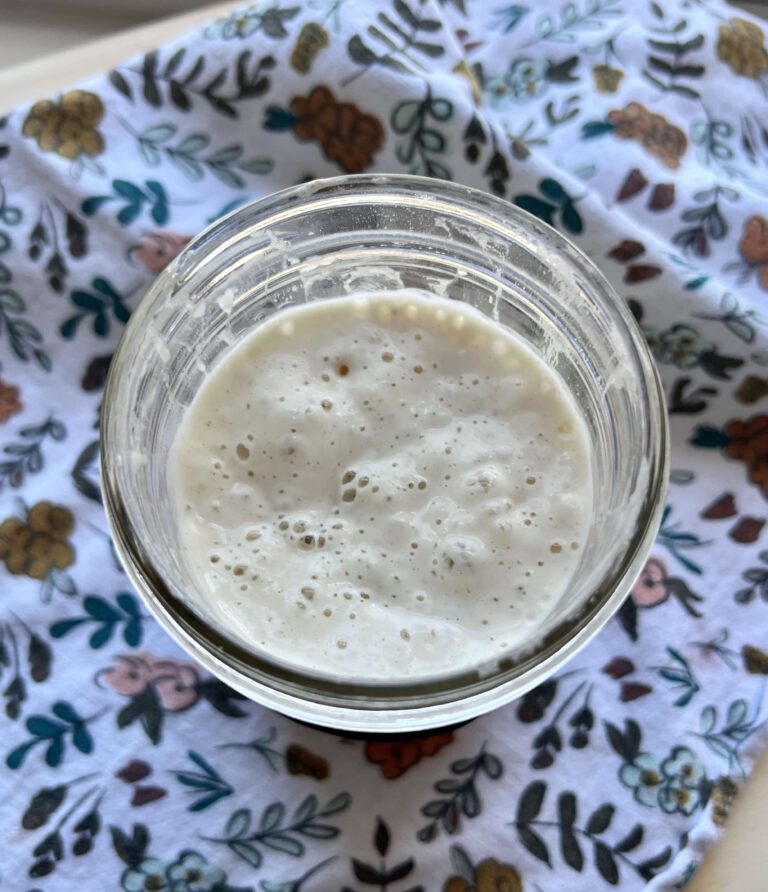



Hi Amy,
Thank you for replying to this question. If after I feed my starter 1:1:1 then almost doubled and place in fridge how does it “stay peaked and bubbly”. Wouldn’t it stop in the fridge. I read this in “how to use a refrigerated starter”.
thank you
The refrigerator pauses fermentation – but not forever. It still continues through the fermentation cycle, just much more slowly. So it stays peaked and bubbly (depending on the feeding ratio) for a few hours up to a day or so. You can use it in a recipe or use it to make a levain in this state.
Amy, I have started a sour dough starter and it’s not doing anything?
Make sure you are keeping it warm and using some whole wheat and rye flour. The process can take time, so be patient with it. It is not un-common to take 2-3 weeks until it is rising predictably.